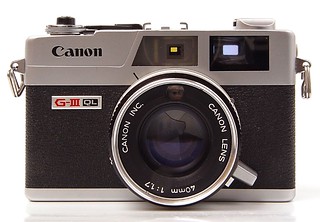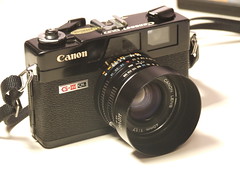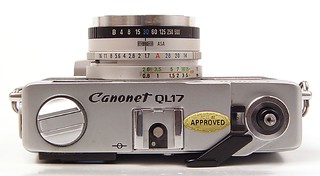Canon Canonet QL 17 GIII

|
| image by Martin Taylor (Image rights) |
The Canonet QL 17 GIII is the final, high-end version of Canon's famous Canonet compact rangefinder series of the 60s and 70s. It provides shutter-priority auto-exposure and parallax compensation with its 40mm f/1.7 lens.
Contents
Physical description
The camera is small for the time, with rounded corners and a black leatherette. Film advance, exposure counter shutter release, rewind crank and the hot shoe are on the top plate, while the battery check is on the viewfinder eye-piece, and the rewind button, tripod socket and battery compartment are on the bottom plate. All other controls are on the lens body.
Focusing and optics
The coated, house-made lens is, like many rangefinder lenses, at the wide end of what might be considered the "normal lens" range, at 40mm. This is actually closer to the diagonal of one full frame of 35mm; a good rule of thumb is that a focal length equal to the frame's diagonal approximates the effective field of view of the human eyes (i.e., both eyes minus the peripheral vision area,) which is considered to be the desired field of view for a normal. 40mm at one time was a more common figure for the "normal" lens, until the advent of the fast 50mm SLR lenses.
The lens is decently fast for the time at f/1.7, a figure Canon were apparently very proud of, as the camera and two of its predecessors were named after it. The aperture is partially controlled by the shutter-priority circuits, and so behaves rather oddly. If one manually widens the aperture while the camera is un-cocked, nothing appears to happen until the film is advanced, when the diaphragm snaps to the selected aperture. The same is not true of stopping down the aperture while the camera is un-cocked. When the camera is cocked, the aperture may be adjusted in either direction normally. When the camera is set to autoexposure mode, the aperture remains wide open and stops down when the shutter release is pressed.
Focusing is by coincident-image range-finder. The QL17 has a fairly advanced rangefinder, with bright frame-lines that move diagonally down and to the right when the camera is focused in the near-field, to correct for parallax. Also lit by the same window is the meter, which shows the aperture being selected by the autoexposure circuit; curiously, the scale skips f/2. The rangefinder spot is fairly large, bright and rectangular, appearing yellow against a rose-tinted image.
The focus is manipulated by a lever operated by the photographer's left hand. There is a range-indicator in both meters and feet, but no depth-of-field scale. The lens is sharpest at f/4 - f/5.6 [1].
Shutter
The camera has a conventional Copal leaf shutter in a between-lens position. It offers shutter speeds from 1/4 to 1/500, with X flash sync at any speed.
Metering and automation
The meter is a CdS cell mounted on the lens, just above the front element, with its own Fresnel condensing lens and an aperture dial which moves with the shutter-speed selector, allowing more or less light to fall on the meter depending on the shutter speed. The camera offers shutter priority autoexposure for film speeds between 25 and 800 ASA, as well as unmetered manual exposure mode. In shutter-priority mode, the automatically selected aperture is indicated in the viewfinder by the meter gauge. Since the metering unit is placed within the filter thread, the camera compensates automatically and perfectly for any filter (assuming the filter is uniform across its width,) because the filter affects the meter in the exact same way that it will affect the film.
The camera was designed to use the PX625 mercury battery, no longer available in the US. The circuitry in the camera holds up well against slightly higher voltages, so one may use a PX625A alkaline battery as a drop-in replacement, but this will cause exposure errors at the beginning and end of the battery's life. The only mechanism that requires a battery is the meter, so the camera may be used manually without a battery.
Flash
A dedicated flash unit was sold with this Canonet, the Canolite, which communicates via a specialized contact in the Canonet's hot shoe, and synchronizes with the camera in autoexposure mode at any shutter speed. There is also a PC socket beneath a plastic cover on the left of the body, near the carrying eyes.
For non Canolite flashes, there are dedicated auto-exposure modes for three different "guide numbers. Guide numbers are a component in a fairly archaic system for calculating the necessary aperture from flash intensity, distance, and film speed, of which the details are obscure. The camera expects the photographer to do about half the math when shooting with a flashbulb or a non-Canolite flash, in summation.

|
| QL 17 GIII in black image by Denny Narciso (Image rights) |
Conclusion
The QL 17 GIII is considered an excellent camera for the price, both new and resale. It is about two-thirds the weight of a Leica M6, and is said to be much quieter (having a leaf shutter instead of a focal-plane shutter). It is often recommended as an alternative to higher-priced rangefinder cameras. They can often be found on eBay for as little as $30, and with over a million of the cameras sold, they are fairly common at flea markets and garage sales as well. It is certainly in the upper tier for fixed-lens rangefinders, and certainly one of the cheapest cameras in that tier.
Technical Specs
- Type: Rangefinder camera
- Manufacturer: Canon Inc. Japan
- Lens: Canon Lens 40mm f/1.7. 6-element 4-group construction, with four newly designed glasses. Spectra coated in amber and purple. Filter thread 48mm.
- Shutter: Between-the-lens type. Shutter speeds from 1/4 to 1/500 sec. and B. Automatically sets aperture, self-cocking combined film/shutter wind, self-timer, X-synchronization.
- Viewfinder: Bright-Line type, Parallax Correction Mark
- Rangefinder: Viewfinder combined with range-finder, bright frame with automatic parallax correction, aperture scale, exposure indicator, over/under exposure indicator, and over/under warning marks.
- EE Mechanism: Built in exposure meter with CdS cell for fully automatic exposure control. Shutter speed priority system. ASA 25-800 (DIN 15-30). With ASA 100 film, EV 3.5 (f/1.7 at 1/4 sec.) EV 17 (f/16 at 1/500 sec.)
- Battery: Originally powered by one 1.35V M20 (#625) mercury battery. Battery checker built-in. (It's possible to use alternatives. *see above)
- Flash: Hot shoe Accessory shoe with direct contact exclusive for Canolite D and the flash socket for the other flash units. Electronic Flash Sync with All Shutter Speeds.
- Weight: 620g
Notes
Links

|
| image by Martin Taylor (Image rights) |
- Karen Nakamura's overview at Photoethnography
- Steven Gandy's overview at Cameraquest
- Canonet QL17 versus the Leica M6 (archived) by Kyle Cassidy
- Matt Denton's overview (including repair tips)
- Repair Notes by Rick Oleson
- Henry Taber's guide to Canonet blade cleaning
- Favorite Classics on the GIII
- Instruction Manuals
- The Other Martin Taylor's opinion on the GIII
- Lionel's Canonet QL17 GIII overview at 35mm-compact.com (in French)
- Canon Canonet GIII at Sylvain Halgand's www.collection-appareils.fr (in French)
Photos
- Random photos from pbase
- Flickr QL17 group